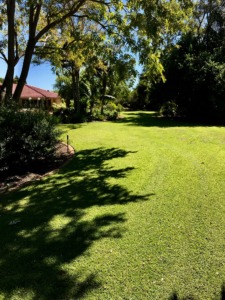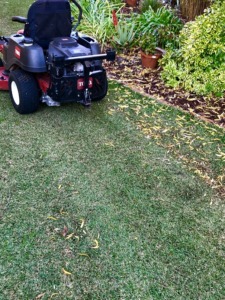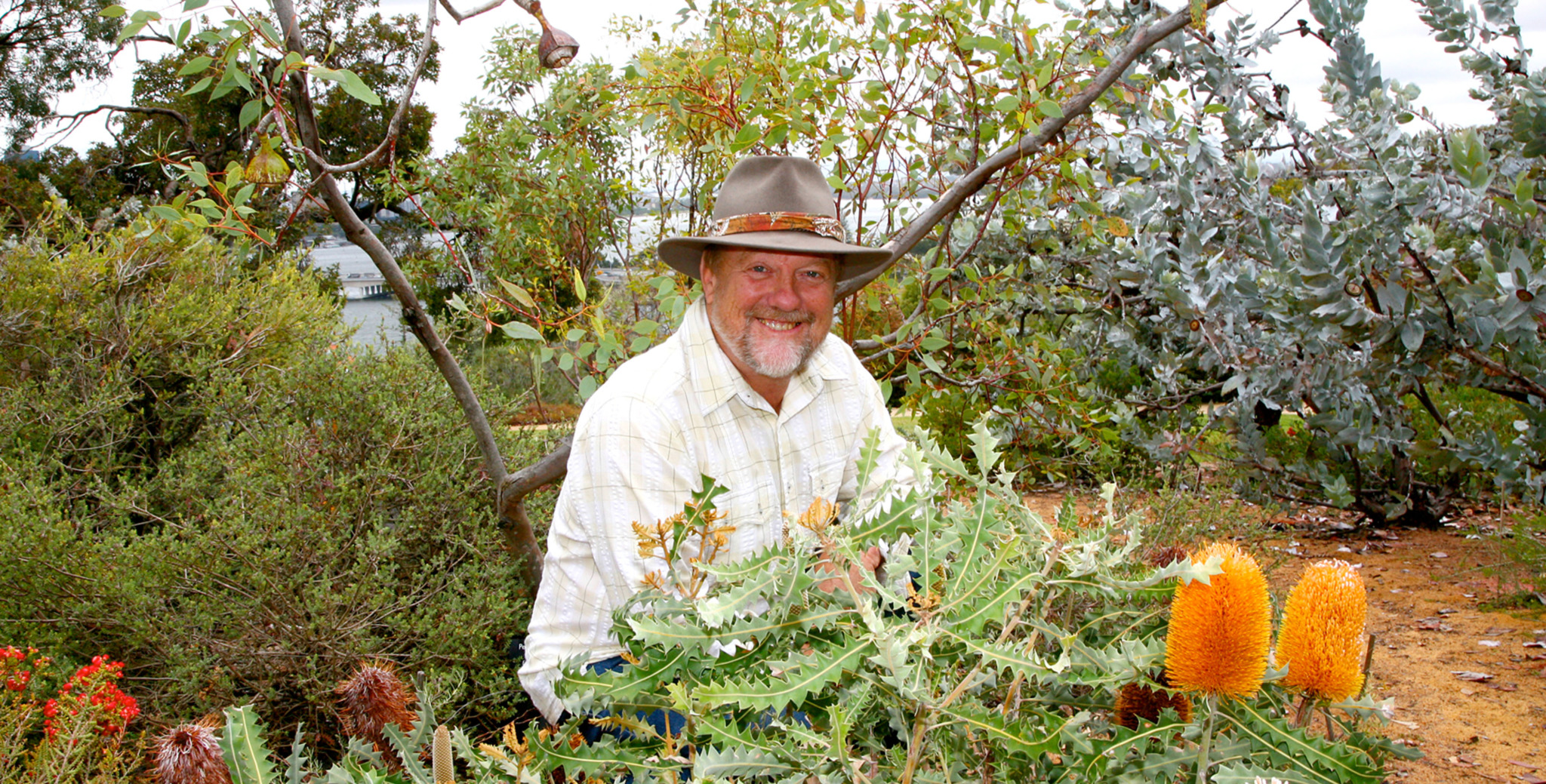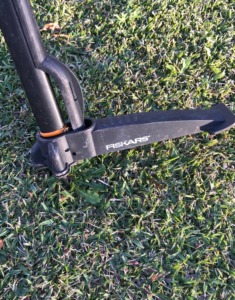The grass is greener on the other side of fertiliser.
Can you have green lawns without fertiliser? If you had asked this question seven years ago I would have replied, “In Perth’s sandy soils? You’re dreaming!”
 Six years ago I started looking after a large expanse of lawn mostly buffalo with some patches of Kikuyu and couch using a mulching ride-on mower. At the time the grass was fairly weedy with a range of annual and perennial weeds.
Six years ago I started looking after a large expanse of lawn mostly buffalo with some patches of Kikuyu and couch using a mulching ride-on mower. At the time the grass was fairly weedy with a range of annual and perennial weeds.
The strategy I adopted was to mow the lawn once a week to cut off the flowers of the weeds so that the lawn could eventually overtake the pests.
The plan worked pretty well and I did get control over the worst weed infestations including Bindii or jo-jo, the summer prickle grass and clover in winter. The unexpected result was the lawn stayed green all year round and I didn’t need to apply any fertiliser.
There was a further surprise in store for me. Couch and to a lesser extent, Kikuyu, have a tendency to thatch up over a year or so, making the lawn spongy and unthrifty.
Thatch consists of a layer of stems and partially rotten grass clippings that sit on the surface of the soil under the foliage cover of the lawn.
This layer can impede water movement through to the root zone and often is associated with moisture repellent soil, which leads to patchiness in the grass. With all the grass clippings going back into the lawn I figured I was certain to have thatch problems arising soon after the change of routine but no evidence appeared.
All of this needs to be thought through – what is happening here? Firstly I looked at the mower. The sharp blade operates at high speed and produces finely textured clippings, which are forced under pressure, back into the lawn. You don’t have a grass catcher with these mowers, yet there is no evidence of any clippings sitting on the surface after you pass over the lawn.
If you have ever composted your own clippings you will have noticed how quickly these start to heat up. This is a result of high levels of nitrogen in the green leaves, which fuels rapid breakdown. This same element nitrogen in a different form is the major element in lawn fertilisers, which promotes rapid green growth.
By pumping these fine clippings back into the grass I am providing nutrition for the lawn plant. Naturally occurring bacteria and fungi living in the soil break down the clippings into a form of nutrient that the grass can take up and use to fuel its own growth.
 Mulching mowers are a form of rotary mowers. These tend to be more expensive to buy than regular rotary types but are well below the cost of reel mowers. The main drawback is the need to up the regularity of cutting your lawn, however the payback is less weeds and no need to fertilise your lawn.
Mulching mowers are a form of rotary mowers. These tend to be more expensive to buy than regular rotary types but are well below the cost of reel mowers. The main drawback is the need to up the regularity of cutting your lawn, however the payback is less weeds and no need to fertilise your lawn.
My goal is to cut out the use of both fertilisers and pesticides on my lawn and move in a more organic direction.
One motivation is the knowledge that approximately 60% of applied fertilisers miss the target, which means that most of that fertiliser goes into aquifers or is washed into the soil.
That unique, sometimes cursed, sandy soil that we live on acts like a sponge, sucking up nutrients and moving these via underground streams into rivers, wetlands and lakes.
Unwanted nutrients cause a wide range of problems for our waterways and wildlife.
Weedicides, fungicides and insecticides are also on the list of undesirables in my garden. This is motivated by research that shows every biocide used in the garden has unexpected, usually catastrophic, side effects on soil biology as well as predator insects.
Left alone to Her own devices, Mother Nature always strives for a positive balance that enhances plant growth. Far from being a wishful thinking, hippy comment this is how the biological world works.
Plants are at the centre of this universe because they have the unique ability to produce food, through photosynthesis, that virtually all other organism require.
So why don’t I get thatch in my lawn?
My belief is that the natural food I am supplying via the fine leaf clippings is decomposed by the soil life and turned into humus in the soil. Thatch is a sign that your soil life is depleted and is not able to cope with breaking down plant matter, so that it accumulates at soil level and becomes a problem.
While the regular cutting has helped control most annual weeds, it’s not worked with dandelion and flat weed, both of which grow low and flat.
To combat these two I bring out my trusty weed puller. I stab the centre of the weed with the jaws and lean the handle to one side and it pulls the weed from the soil. Next I eject the weed into a bin.
I have had mixed success getting the younger members of the family to enter into a contract to remove these weeds at a fee of 10 cents each.
How can you feed your lawn if a mulching mower is not a possibility for you at the moment?
I would like to suggest three main options. First is the use of organic fertilisers such as Blood and Bone or poultry manure based pellets such as Dynamic Lifter, these are generally mild acting. In the case of the pellets these have undergone a process of composting, so these are not raw manures, which can burn sensitive plants.
The second option is the application of finely sieved compost. These products are available in bags from your local garden centre under the names of ‘lawn reviver’ or ‘lawn top dresser’. These can be applied two to three times a year as a thin layer, such as one centimetre thick. Rake the material vigorously into the lawn surface and then water heavily. Once completed you should see something approximating 50% green and 50% black. A week later you should have difficulty finding any black, as the grass will have pushed through.
The third alternative is a hybrid fertiliser that features an organic base with supplements of regular mineral fertilisers. Many of these hybrids also have biological stimulants in the mix. These all feature mild plant foods with nitrogen percentages under 10%.
The latest buzzword in fertilisers is “bio-stimulant”. The term covers a wide range of products, which include things like seaweed extracts as well as cultivated fungi, and bacteria, which act like soil life or even stimulate the native soil life.
While this is the fastest growing segment of the fertiliser market and it’s likely that it will overtake conventional fertilisers in the next decade, I am looking to good science to lead us forward here. UWA Professor Lyn Abbott is a soil scientist and is already engaged in evaluating the effectiveness of these bio-stimulants particularly though the lens of our sandy WA soils and our climate.
I am highly encouraged by the organic approach being taken by some golf courses in WA as well as a few turf producers. The home of golf, The Old Course at St Andrews in Scotland, was started around 450 years ago, before synthetic fertilisers were invented. To this day they use compost as their principle feeding medium.
“Business as usual” is not serving our planet well in every aspect of horticulture and agriculture. We all need to change the way we operate when we are dealing with growing food or our suburban lawn.
I hope I might have inspired you to try a different road with your patch of living greenery at home.


